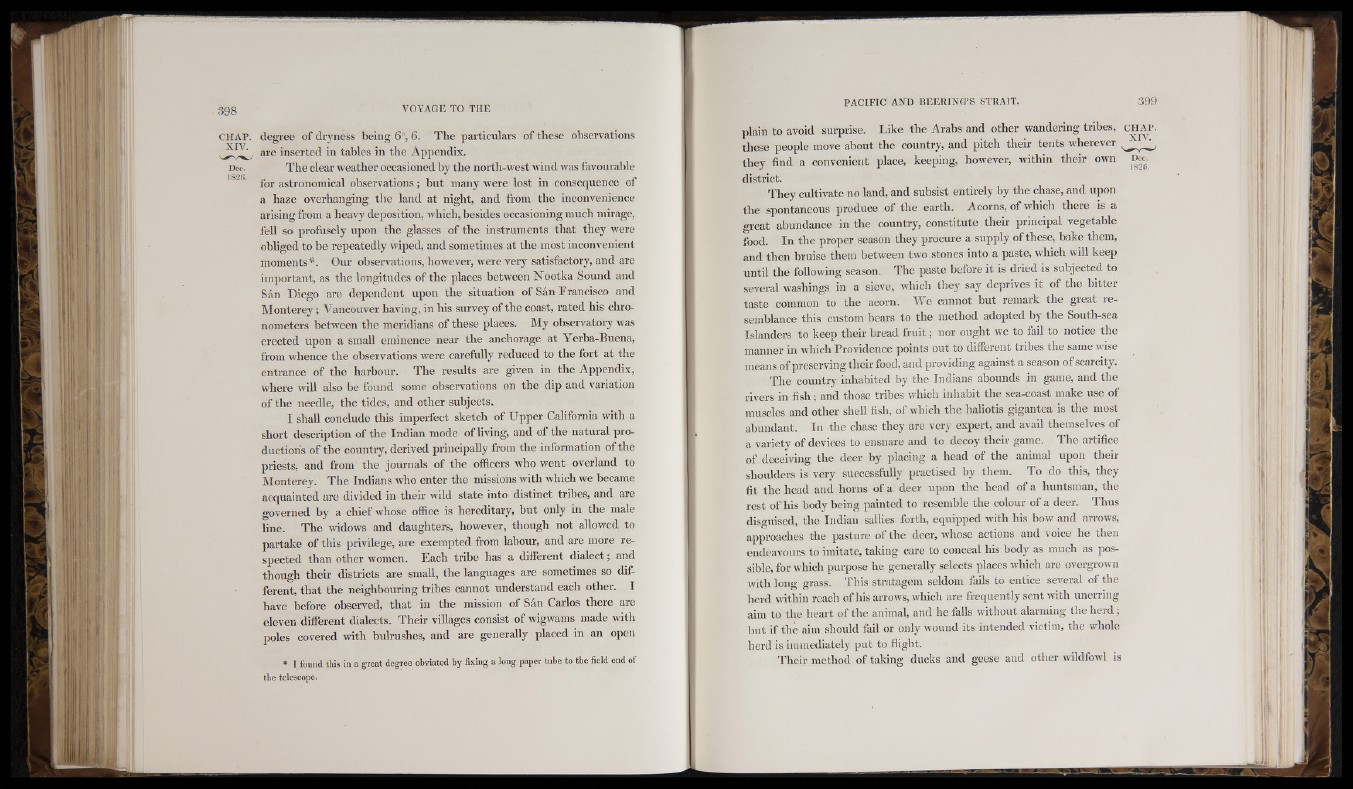
Iri:' ' i:
I
■
i; ito
i:::: ‘
ifiir I
!!!" ■ i
CHAP.
XIV.
nec.
I S 2 6 .
degree of dryness being 6°, 6. The particulars of these observations
are inserted in tables in the Appendix.
The clear weather occasioned by the north-west wind was favourable
for astronomical observations; but many were lost in consequence of
a haze overhanging the land at night, and from the inconvenience
arising from a heavy deposition, which, besides occasioning much mirage,
fell so profusely upon the glasses of the instruments that they were
obliged to be repeatedly wiped, and sometimes at the most inconvenient
moments*. Our observations, however, were very satisfactory, and are
important, as the longitudes of the places between Nootka Sound and
Sán Diego are dependent upon the situation of Sán Francisco and
Monterey; Vancouver having, in his survey of the coast, rated his chronometers
between the meridians of these places. My observatory was
erected upon a small eminence near the anchorage at Yerba-Buena,
from whence the observations were carefully reduced to the fort at the
entrance of the harbour. The results are given in the Appendix,
where will also be found some observations on the dip and variation
of the needle, the tides, and other subjects.
I shall conclude this imperfect sketch of Upper California with a
short description of the Indian mode of living, and of the natural production's
of the country, derived principally from the information of the
priests, and from the journals of the officers who went overland to
Monterey. The Indians who enter the missions with which we became
acquainted are divided in their wild state into distinct tribes, and are
governed by a chief whose office is hereditary, but only in the male
line. The widows and daughters, however, though not allowed to
partake of this privilege, are exempted from labour, and are more respected
than other women. Each tribe has a different dialect; and
though their districts are small, the languages are sometimes so different,
that the neighbouring tribes cannot understand each other. I
have before observed, that in the mission of Sán Carlos there are
eleven different dialects. Their villages consist of wigwams made with
poles covered with bulrushes, and are generally placed in an open
* I found this in a ¡
the telescope.
t degree obviated by fixing a long paper tube to the field end of
plain to avoid surprise. Like the Arabs and other wandering tribes, C H A I ' .
these people move about the country, and pitch their tents wherever
they find a convenient place, keeping, however, within their own Dec,
district.
They cultivate no land, and subsist entirely by the chase, and upon
the spontaneous produce of the earth. Acorns, of which there is a
great abundance in the country, constitute their principal vegetable
food. In the proper season they procure a supply of these, bake tliem,
and then bruise them between two stones into a paste, wliich will keep
until the following season. The paste before it is dried is subjected to
several washings in a sieve, which they say deprives it of the bitter
taste common to the acorn. We cannot but remark the great resemblance
this custom bears to the method adopted by the South-sea
Islanders to keep their bread fruit ; nor ought we to fail to notice the
manner in which Providence points out to different tribes the same wise
means of preserving their food, and providing against a season of scarcity.
The country inhabited by tbe Indians abounds in game, and the
rivers in fish ; and those tribes which inhabit the sea-coast make use of
muscles and other shell fish, of which the haliotis gigantea is the most
abundant. In the chase they are very expert, and avail themselves of
a variety of devices to ensnare and to decoy their game. The artifice
of deceiving the deer by placing a head of the animal upon their
shoulders is very successfully practised by them. To do this, they
fit the head and horns of a deer upon the head of a huntsman, the
rest of his body being painted to resemble the colour of a deer. Thus
disguised, the Indian sallies forth, equipped with his bow and arrows,
approaches the pasture of the deer, whose actions and voice he then
endeavours to imitate, taking care to conceal his body as much as possible,
for which purpose he generally selects places which are overgrown
with long grass. This stratagem seldom fails to entice several of the
herd within reach of Ills arrows, which are frequently sent with unerring
aim to the heart of the animal, and he falls without alarming the herd ;
but if thè aim should fail or only w'Ound its intended victim, the whole
herd is immediately put to flight.
Their method of taking ducks and geese and other wildfowl is
i!
'I:
A l